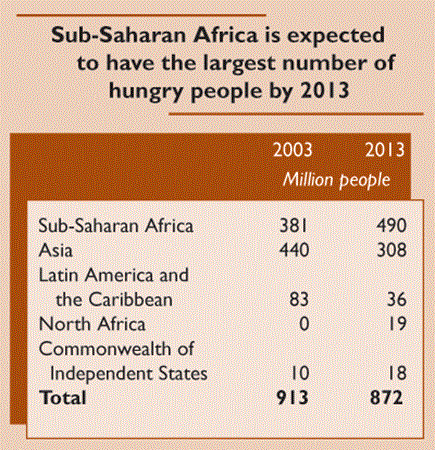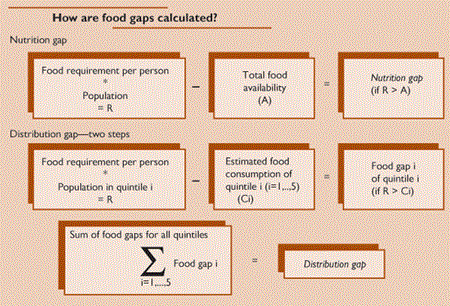Behind the Data
Estimating Food Access and Food Gaps in Low-Income Countries
ERS contributes to the understanding of global food security, including decisions on how U.S. food aid is allocated, by providing annual estimates of food gaps. Food security, defined as access by all people at all times to enough food for an active and healthy life, requires three conditions to be fulfilled: food must be available, people must have economic access to food, and food must be properly utilized (that is, properly prepared and containing nutrients that can be absorbed by the body). The Food Security Assessment model addresses the first two conditions, as it is used to estimate food availability in order to estimate people’s economic access to food. The level of food security of a country is evaluated based on the gap between estimated food supplies and the food required to meet average individual nutritional standards (approximately 2,100 calories per day per person).
The indicators cover 70 low-income developing countries—37 in Sub-Saharan Africa, 4 in North Africa, 11 in Latin America and the Caribbean, 10 in Asia, and 8 in the Commonwealth of Independent States. Total food availability is estimated from separate country models, which include three commodity groups: grains, root crops, and “other.” The model structure is based on estimates of the factors affecting in-country food production and imports. Food requirements and food access are based on population projections, a minimum standard for nutritional intake per person, and income levels. The models are updated annually with data from the U.S. Department of Agriculture, the U.N. Food and Agriculture Organization, the World Food Program, and the World Bank.
The gap between food available at the national level and food needed to fulfill all nutritional requirements is called the nutrition gap, a food security indicator useful in assessing relative well-being across countries. However, national estimates fail to take into account that food is distributed unevenly among income groups. To capture unequal access to food within the countries, the ERS Food Security Assessment model estimates a nutrition gap for each income group within a country—the so-called distribution gap. Data on food consumption by different income groups within countries are spotty, but national income and consumption data are available. Data from 60 countries of different income levels are used to estimate income elasticities (percentage change in consumption for each 1-percent change in income) of food consumption. Next, these elasticities, along with per capita income and income distribution, are used to estimate food consumption in each income quintile. Where food consumption is less than nutritional requirements, the distribution gap measures the food needed to fill these gaps. The share of population with insufficient access to food is used to estimate the number of people susceptible to undernutrition and hunger.
Each year, ERS publishes food gap estimates for the current year and projections for the next 10 years. The 2003 distribution gap was estimated to be 32.5 million tons, 77 percent larger than the nutrition gap, but it is projected to decline 14 percent over the next 10 years. Sub-Saharan Africa, the region with the largest food gaps, is expected to have the highest number of hungry people by 2013, surpassing Asia, which is expected to reduce its number of hungry people.
Food Security Assessment, GFA-15, by Stacey Rosen, Shahla Shapouri, Birgit Meade, Michael Trueblood, William M. Liefert, and Constanza Valdes, USDA, Economic Research Service, May 2004



